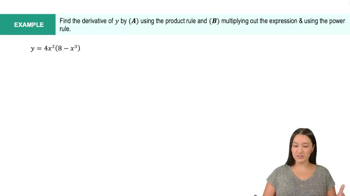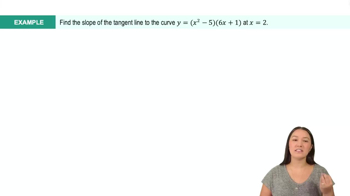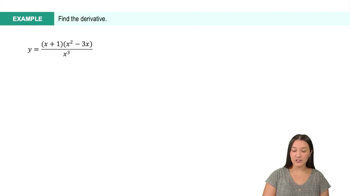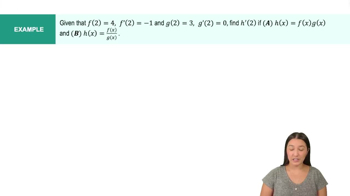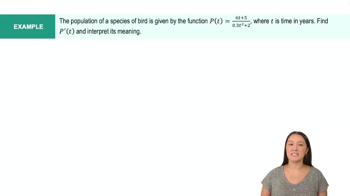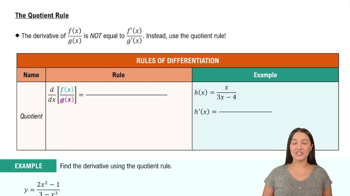Table of contents
- 0. Functions7h 52m
- Introduction to Functions16m
- Piecewise Functions10m
- Properties of Functions9m
- Common Functions1h 8m
- Transformations5m
- Combining Functions27m
- Exponent rules32m
- Exponential Functions28m
- Logarithmic Functions24m
- Properties of Logarithms34m
- Exponential & Logarithmic Equations35m
- Introduction to Trigonometric Functions38m
- Graphs of Trigonometric Functions44m
- Trigonometric Identities47m
- Inverse Trigonometric Functions48m
- 1. Limits and Continuity2h 2m
- 2. Intro to Derivatives1h 33m
- 3. Techniques of Differentiation3h 18m
- 4. Applications of Derivatives2h 38m
- 5. Graphical Applications of Derivatives6h 2m
- 6. Derivatives of Inverse, Exponential, & Logarithmic Functions2h 37m
- 7. Antiderivatives & Indefinite Integrals1h 26m
- 8. Definite Integrals4h 44m
- 9. Graphical Applications of Integrals2h 27m
- 10. Physics Applications of Integrals 2h 22m
3. Techniques of Differentiation
Product and Quotient Rules
Problem 3.4.23
Textbook Question
Derivatives Find and simplify the derivative of the following functions.
f(t) = t⁵/³e^t
 Verified step by step guidance
Verified step by step guidance1
Step 1: Identify the function f(t) = t^{5/3} e^t as a product of two functions: u(t) = t^{5/3} and v(t) = e^t.
Step 2: Apply the product rule for derivatives, which states that if you have a function h(t) = u(t)v(t), then h'(t) = u'(t)v(t) + u(t)v'(t).
Step 3: Differentiate u(t) = t^{5/3} using the power rule. The power rule states that if u(t) = t^n, then u'(t) = n t^{n-1}. So, u'(t) = \frac{5}{3} t^{\frac{5}{3} - 1}.
Step 4: Differentiate v(t) = e^t. The derivative of e^t with respect to t is simply e^t, so v'(t) = e^t.
Step 5: Substitute u(t), u'(t), v(t), and v'(t) into the product rule formula: f'(t) = u'(t)v(t) + u(t)v'(t) = \frac{5}{3} t^{\frac{2}{3}} e^t + t^{\frac{5}{3}} e^t.
 Verified video answer for a similar problem:
Verified video answer for a similar problem:This video solution was recommended by our tutors as helpful for the problem above
Video duration:
4mPlay a video:
Was this helpful?
Key Concepts
Here are the essential concepts you must grasp in order to answer the question correctly.
Derivatives
A derivative represents the rate of change of a function with respect to its variable. It is a fundamental concept in calculus that allows us to determine how a function behaves at any given point. The derivative can be interpreted as the slope of the tangent line to the curve of the function at a specific point.
Recommended video:

Derivatives
Product Rule
The Product Rule is a formula used to find the derivative of the product of two functions. It states that if you have two functions, u(t) and v(t), the derivative of their product is given by u'v + uv'. This rule is essential when differentiating functions that are products of simpler functions, such as polynomials and exponentials.
Recommended video:
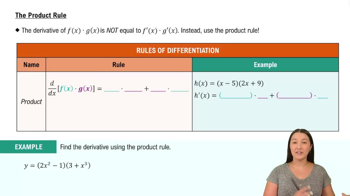
The Product Rule
Exponential Functions
Exponential functions are functions of the form f(t) = a * e^(kt), where 'e' is the base of natural logarithms, and 'a' and 'k' are constants. The derivative of an exponential function is unique because it is proportional to the function itself, making it straightforward to differentiate. Understanding how to differentiate exponential functions is crucial when they are part of more complex expressions.
Recommended video:
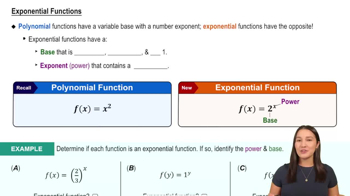
Exponential Functions
Related Videos
Related Practice



